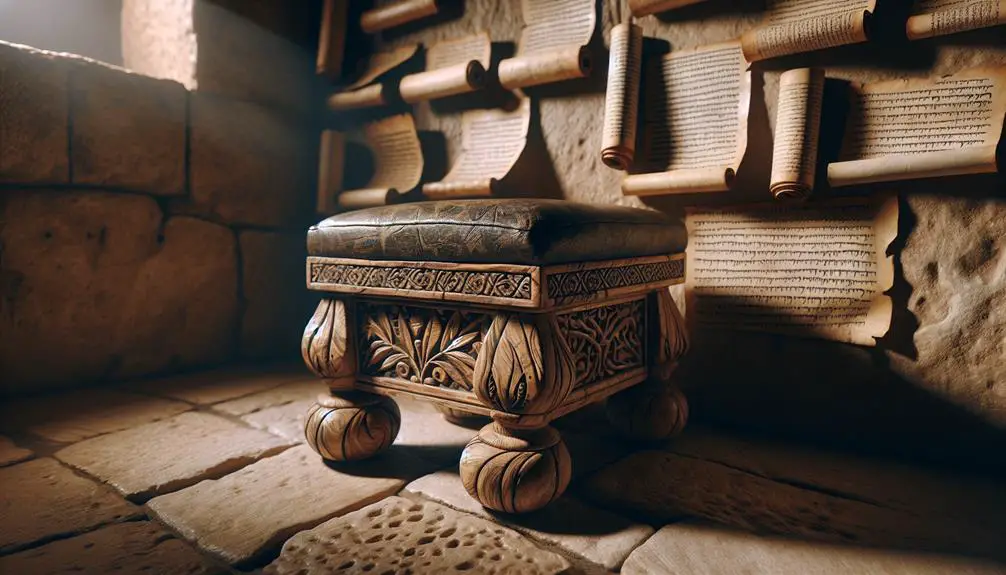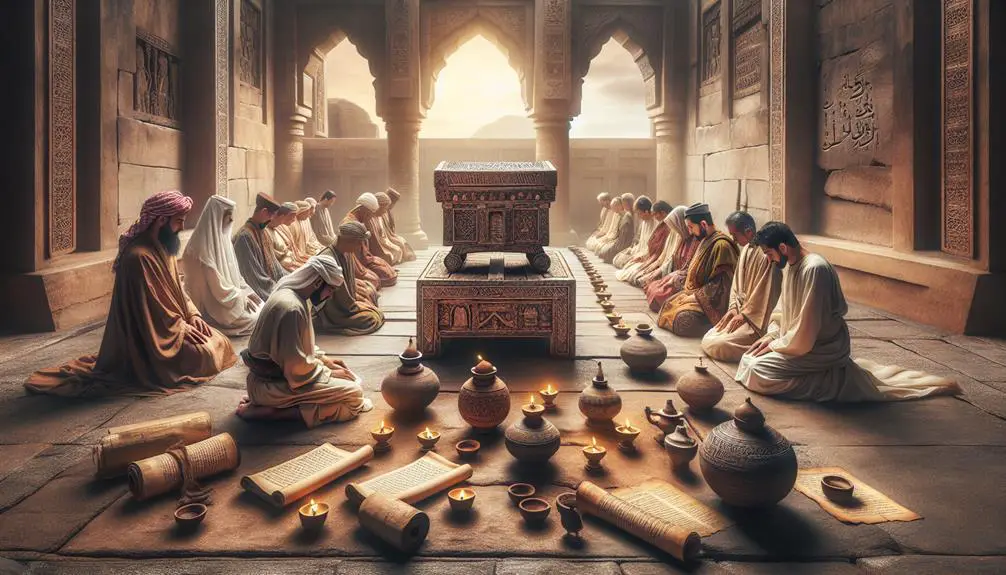Crack the hidden symbolism of footstools in the Bible, and discover layers of meaning that redefine divine authority and conquest.

Footstool in the Bible
Have you ever wondered if there's more to the term 'footstool' in the Bible than meets the eye?
This seemingly mundane object takes on profound symbolic dimensions in the scriptures, from representing the earth under God's feet to signifying the subjugation of enemies under a king's rule.
As you explore the passages where footstools are mentioned, you'll uncover layers of meaning that could shift your understanding of biblical texts.
So, why not join the conversation and see what insights await as we untangle the symbolism and significance of footstools across both the Old and New Testaments?
Key Takeaways
- Footstools symbolize divine authority and the hierarchy between God, kings, and subjects in the Bible.
- They reflect humanity's stewardship role on Earth, emphasizing environmental care as a spiritual duty.
- In prophetic visions, footstools represent God's triumph over enemies and establish His ultimate sovereignty.
- New Testament teachings use footstool imagery to underscore Jesus' authority, humility, and the establishment of God's eternal kingdom.
The Symbolism of Footstools

In biblical contexts, footstools carry profound symbolic significance, often representing dominion and authority. This notion isn't merely a relic of ancient texts; it's woven deeply into the fabric of domestic symbolism and cultural interpretations. You see, footstools aren't just furniture; they're emblematic of the power dynamics within a household. In a domestic setting, the head of the household's use of a footstool can subtly signal their status and control over their domain.
Furthermore, cultural interpretations of footstools extend beyond the confines of a single home. Across various societies, a ruler's possession of a footstool has historically signified their dominion over their subjects and territories. This imagery is potent, framing the ruler not just as a figure of authority but as one having an almost divine right to command and conquer.
Analyzing these symbols, you'll find that footstools are far from mundane. They embody the intersection of power, authority, and societal hierarchy. In a biblical sense, the use of footstools by deities or figures of spiritual significance underscores their unparalleled sovereignty and the submission of their foes. This isn't mere furniture; it's a declaration of supremacy, a tangible representation of an intangible concept.
Footstools in Ancient Worship

Understanding the symbolic significance of footstools leads us directly to their role in ancient worship, where they served not only as physical objects but also as profound spiritual symbols. In the context of temple design, footstools were meticulously incorporated, reflecting a deep integration of form and function aligned with religious beliefs. These objects weren't mere pieces of furniture; they were imbued with symbolism, representing the divine authority and presence.
In the realm of worship rituals, footstools took on a pivotal role. They were often positioned in sacred spaces to signify the threshold between the divine and the earthly realms. Priests and worshippers engaged with these objects in a manner that underscored reverence and submission to the divine will. The act of kneeling or prostrating oneself before a footstool wasn't just a gesture of humility; it was a profound act of worship, acknowledging the sovereignty of the divine.
The design of these footstools, too, was laden with symbolic meaning. Crafted from materials considered precious within the culture, and often adorned with intricate designs, these footstools served as visual reminders of the wealth of spiritual significance the ancient worshippers placed on their relationship with the divine. Each detail in their construction was a testament to the meticulous care that went into temple worship and the deep-seated belief in the sacredness of their interactions with the divine.
Thus, in ancient worship, footstools were far more than functional items. They were central to the expression of faith and piety, embodying the profound intersection of human devotion and divine majesty.
God's Footstool: Earth and Heaven

Exploring the concept of God's footstool reveals a profound connection between heaven and earth, symbolizing divine authority and presence in the physical world. This imagery, rich in architectural metaphors, underscores the intricate relationship between the celestial and the terrestrial. You'll find that the Bible's use of 'footstool' not only denotes God's sovereignty over all creation but also implies a stewardship role for humanity on earth.
Delving deeper, this concept isn't just about dominion; it's an invitation to environmental stewardship. As God's footstool, the earth is depicted as a sacred space, entrusted to humans. This stewardship calls for a respectful and caring attitude towards the environment, reflecting an understanding of the divine presence in every aspect of the natural world. The architectural metaphor extends beyond a mere structural analogy, suggesting that just as a footstool supports one's feet, so too should humans support and maintain the balance and well-being of the earth.
The connection between heaven and earth as God's footstool challenges you to view the world not as a resource to be exploited, but as a sacred trust. This perspective encourages a deeper appreciation of the natural world and a commitment to sustainable living practices. By embracing this role, you participate in a divine mandate, ensuring that the earth remains a fitting footstool for the divine, bridging the gap between the heavenly and the earthly realms.
This understanding elevates the concept of environmental stewardship to a spiritual duty, underlining the significance of the earth in the divine order and humanity's responsibility to honor this sacred trust.
Footstools and Kingship in Psalms

The concept of footstools in the Book of Psalms intricately weaves together themes of kingship and divine authority, illuminating the profound relationship between God and His creation. Through the imagery of footstools, Psalms presents a royal posture that signifies power, dominion, and the establishment of God's kingdom. This imagery isn't just metaphorical; it's deeply rooted in the culture and enthronement rituals of the time, offering a rich tapestry of meaning that speaks volumes about the nature of divine kingship.
- Royal Posture: The depiction of God's footstool in Psalms isn't merely about physical comfort or aesthetic; it's a symbol of authority. Kings of the earth might use footstools, but when Psalms speak of God's footstool, it elevates the concept to a divine level. It signifies God's absolute rule and His position above all creation.
- Divine Authority: Through this imagery, Psalms asserts God's ultimate authority over the earth. The earth as His footstool doesn't just mean dominion in a general sense, but a personal, active involvement in the world.
- Enthronement Rituals: The references to footstools in Psalms echo ancient Near Eastern enthronement ceremonies, where a new king's rise to power was symbolized by his feet being placed on a footstool. This parallel draws a powerful connection between God's kingship and earthly rulers, yet places God in an incomparably higher position.
- Establishment of God's Kingdom: Psalms uses the footstool motif to prophesy and affirm the coming of God's kingdom. It's not just about present dominion but points forward to a time when God's rule will be fully realized and acknowledged by all creation.
Prophetic Visions and Footstools

Prophetic visions in Scripture often utilize the symbol of a footstool to convey God's ultimate victory and dominion over His enemies. This imagery isn't merely decorative; it's steeped in deep theological significance, offering you a glimpse into the divine plan through the lens of dream interpretation and visionary artistry. When prophets received these visions, they weren't just seeing idle fantasies. Instead, they were given a detailed, symbolic language through which God communicated His sovereignty and judgment.
The footstool motif in prophetic visions serves as a powerful reminder of God's authority. It's as if the prophets are pulling back the curtain of reality to show you that all earthly powers, no matter how formidable they seem, are ultimately subordinate to God's throne. This isn't just about physical dominance; it's a declaration of moral and spiritual victory. The footstool symbolizes the submission and defeat of God's adversaries, reinforcing the idea that His rule is just and absolute.
Dream interpretation plays a crucial role here. The prophets, skilled in deciphering God's messages, understood that the footstool wasn't a literal object to be sought but a metaphor for divine triumph. Their visionary artistry allowed them to communicate this complex concept in terms that people could grasp, bridging the heavenly and the earthly.
The Footstool in New Testament Teachings

Building on this understanding of the footstool as a symbol of divine dominion, New Testament teachings further illuminate its significance in the unfolding story of salvation and God's ultimate authority over creation. Delve deeper, and you'll find that the concept of the footstool isn't merely about conquest or subjugation. Instead, it becomes a profound symbol intertwined with Jesus' humility and the spread of the Gospel through Apostolic references.
- Jesus' Humility and Exaltation: The New Testament recasts the footstool imagery to highlight Jesus' humility. His willingness to become lower than the angels, as mentioned in Hebrews, and his submission to crucifixion, underscore his ultimate exaltation. At God's right hand, every enemy becomes his footstool, echoing the promise of Psalm 110:1.
- Apostolic References to Authority: The apostles frequently reference this imagery to demonstrate Jesus' messianic authority. Acts 2:35 and Hebrews 10:12-13, for instance, use the footstool motif to affirm that Christ's sacrificial death and resurrection placed all things under his feet, emphasizing his role as the ultimate authority.
- The Final Judgment: The footstool imagery also points to the final judgment. Revelations depict Jesus as the righteous judge, with the earth as his footstool, signifying the culmination of God's plan for salvation and the establishment of his eternal kingdom.
- The Kingdom of God: Through Jesus, the footstool becomes a symbol not just of dominion, but of the Kingdom of God itself—where justice, peace, and God's authority are fully realized.
In these ways, the New Testament enriches the symbolism of the footstool, connecting it intricately to Jesus' mission and the Christian faith.
Frequently Asked Questions
How Did the Design and Construction of Footstools Vary Across Different Cultures Mentioned in the Bible?
In exploring how footstool design and construction varied, you'll find that material significance and crafting techniques differed greatly. Cultures prioritized different materials, reflecting their values and resources.
The Egyptians, for instance, favored precious woods and metals, showcasing wealth and divinity. Meanwhile, the Hebrews opted for simpler, functional designs, emphasizing utility.
Each culture's approach to crafting techniques also highlighted their technological advancements and artistic preferences, from intricate carvings to basic assembly.
Can Archaeological Evidence of Footstools From Biblical Times Provide Insights Into the Daily Life and Social Hierarchy of Ancient Civilizations?
Absolutely, archaeological evidence can offer deep insights into ancient civilizations' daily lives and social hierarchies.
By examining and analyzing the materials and employing precise dating methods, you'll uncover the nuanced ways communities lived and structured their social orders.
This approach not only reveals the practical uses of these items but also, through material analysis, illustrates the wealth and status of their owners, providing a detailed, authoritative glimpse into the past.
How Have Modern Interpretations and Artistic Representations of Biblical Footstools Evolved Over Time?
You're diving into how modern interpretations and artistic representations have evolved, focusing on the creative blend of symbolic interpretations and artistic license.
Artists and scholars alike have pushed boundaries, reimagining traditional symbols with contemporary insights. This evolution reflects deeper understandings of cultural and historical contexts, allowing for a richer narrative.
Through these lenses, symbolic elements like footstools gain new dimensions, showcasing the dynamic interplay between tradition and innovation in art and interpretation.
Are There Any Specific Rituals or Customs Associated With Footstools That Were Practiced by People During Biblical Times but Are Not Commonly Known Today?
Interestingly, you might stumble upon the concept of footstools without realizing their rich symbolic history.
While modern adaptations have streamlined their use, ancient rituals and customs tied to footstools are less known today.
These practices, deeply rooted in symbolism, provided nuanced insights into power, servitude, and divine recognition.
An analytical dive into these traditions reveals a complex interplay of beliefs and societal norms, significantly different from today's simplistic use.
What Role Do Footstools Play in Contemporary Religious Ceremonies or Practices Inspired by Biblical Traditions?
In contemporary religious ceremonies, footstool symbolism often reflects humility and servitude, inspired by biblical traditions. Modern adaptations see them used in rituals emphasizing submission to a higher power, mirroring ancient practices.
You'll find footstools in prayer spaces, symbolizing a believer's earthly position relative to the divine. This adaptation bridges historical customs with today's faith expressions, showcasing a profound respect and reverence that transcends time.
Conclusion
In your exploration of biblical references, you've uncovered the multifaceted symbolism of footstools, from divine authority to the humility before God.
Interestingly, the term 'footstool' appears approximately 16 times in various contexts throughout the Bible, underscoring its significance across both Old and New Testaments.
This recurring motif not only highlights the sovereignty of God and the dignity of kingship but also invites readers to reflect on their place in the universe.
Through this analysis, you've gained a deeper appreciation for the intricate layers of biblical language and symbolism.



Sign up